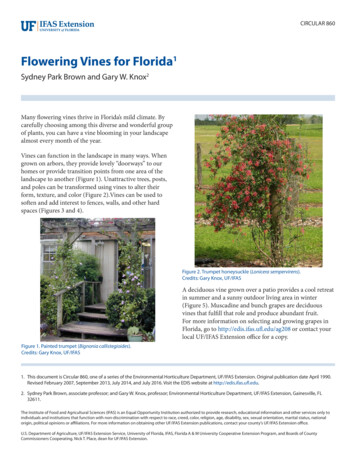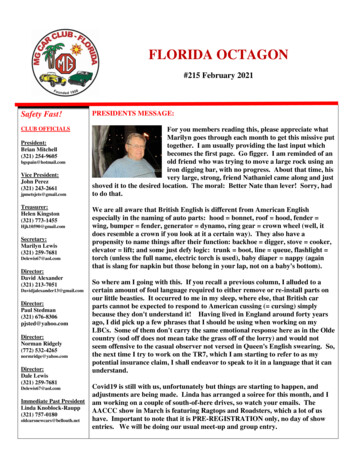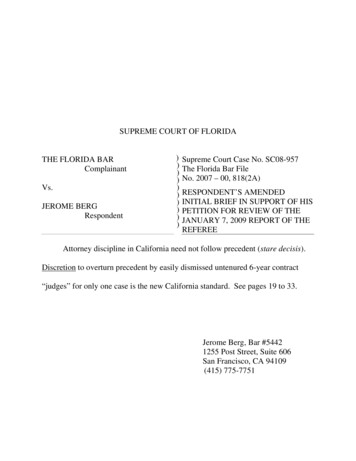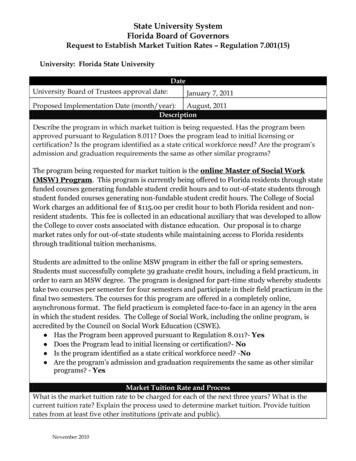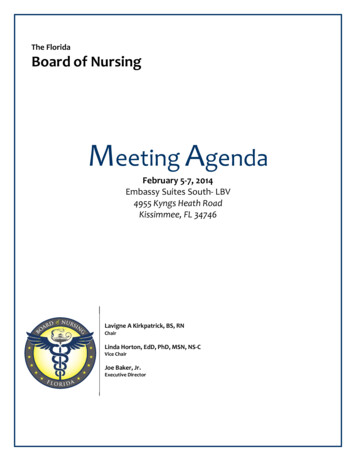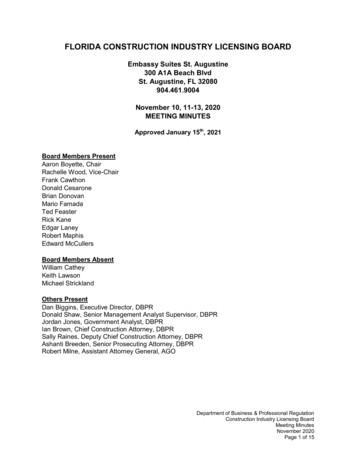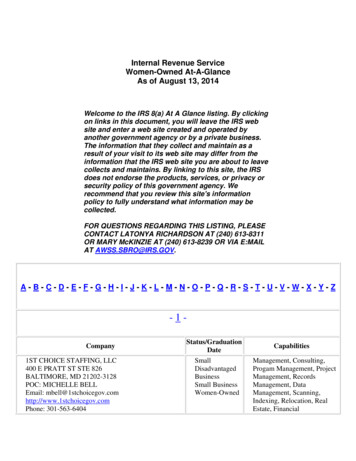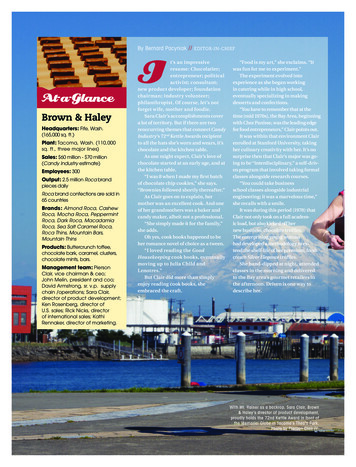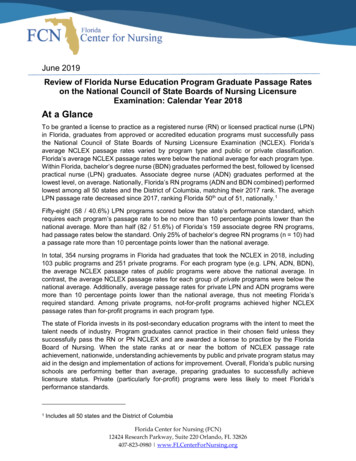
Transcription
June 2019Review of Florida Nurse Education Program Graduate Passage Rateson the National Council of State Boards of Nursing LicensureExamination: Calendar Year 2018At a GlanceTo be granted a license to practice as a registered nurse (RN) or licensed practical nurse (LPN)in Florida, graduates from approved or accredited education programs must successfully passthe National Council of State Boards of Nursing Licensure Examination (NCLEX). Florida’saverage NCLEX passage rates varied by program type and public or private classification.Florida’s average NCLEX passage rates were below the national average for each program type.Within Florida, bachelor’s degree nurse (BDN) graduates performed the best, followed by licensedpractical nurse (LPN) graduates. Associate degree nurse (ADN) graduates performed at thelowest level, on average. Nationally, Florida’s RN programs (ADN and BDN combined) performedlowest among all 50 states and the District of Columbia, matching their 2017 rank. The averageLPN passage rate decreased since 2017, ranking Florida 50th out of 51, nationally. 1Fifty-eight (58 / 40.6%) LPN programs scored below the state’s performance standard, whichrequires each program’s passage rate to be no more than 10 percentage points lower than thenational average. More than half (82 / 51.6%) of Florida’s 159 associate degree RN programs,had passage rates below the standard. Only 25% of bachelor’s degree RN programs (n 10) hada passage rate more than 10 percentage points lower than the national average.In total, 354 nursing programs in Florida had graduates that took the NCLEX in 2018, including103 public programs and 251 private programs. For each program type (e.g. LPN, ADN, BDN),the average NCLEX passage rates of public programs were above the national average. Incontrast, the average NCLEX passage rates for each group of private programs were below thenational average. Additionally, average passage rates for private LPN and ADN programs weremore than 10 percentage points lower than the national average, thus not meeting Florida’srequired standard. Among private programs, not-for-profit programs achieved higher NCLEXpassage rates than for-profit programs in each program type.The state of Florida invests in its post-secondary education programs with the intent to meet thetalent needs of industry. Program graduates cannot practice in their chosen field unless theysuccessfully pass the RN or PN NCLEX and are awarded a license to practice by the FloridaBoard of Nursing. When the state ranks at or near the bottom of NCLEX passage rateachievement, nationwide, understanding achievements by public and private program status mayaid in the design and implementation of actions for improvement. Overall, Florida’s public nursingschools are performing better than average, preparing graduates to successfully achievelicensure status. Private (particularly for-profit) programs were less likely to meet Florida’sperformance standards.1Includes all 50 states and the District of ColumbiaFlorida Center for Nursing (FCN)12424 Research Parkway, Suite 220 Orlando, FL 32826407-823-0980 www.FLCenterForNursing.org
ScopeIn 2017, the Florida Legislature directed the Florida Center for Nursing (FCN) to evaluateprogram-specific data for all approved and accredited nursing education programs in the state,including graduate passage rates on the National Council of State Boards of Nursing LicensureExamination (NCLEX). 2This report is a companion to the FCN report published in January 2019 – Review of Florida’sNursing Education Programs, Academic Year 2017-18. Together the two reports complete thenursing program review, mandated by statute, for Academic Year 2017-2018 and Calendar Year2018. Additional reports on the characteristics of Florida’s nursing LPN, ADN, BSN, post-licensureeducation programs, and nursing program faculty are available on the Florida Center for Nursingwebsite.BackgroundSince 2009 the Legislature has made several statutory changes with the intent to increase thenumber of approved nursing education programs to address Florida’s shortage of nurses. Oneestablished performance standard requires that each program’s graduate passage rate for firsttime NCLEX takers is not more than 10 percentage points lower than the national averagepassage rate for graduates of comparable degree programs during the same calendar year. If aprogram’s passage rate does not meet the requirement for two consecutive calendar years, it isplaced on probation and must submit a remediation plan and increase its passage rate to meetor exceed the required passage rate within timeframes specified in statute. 3This report provides program-specific nursing licensure exam data for all licensed practical andregistered nurse (associate and bachelor’s degrees) education programs 4 in Florida for the 2018calendar year. Data include each program’s passage rate for graduates who took the NCLEX forthe first time and within six months of their graduation date. 5FindingsHow do graduates of Florida programs compare to graduates nationally?Florida’s registered nurse (RN) graduates may complete either an associate degree or abachelor’s degree to qualify for examination. As a group, Florida program graduates performedbelow national averages for their program type (see Exhibit 1, next page).Within Florida, bachelor’s degree (BDN) graduates performed the best (89% passage rate),followed by licensed practical nurse (LPN) graduates (76% passage rate). Associate degree(ADN) graduates performed at the lowest level (68% passage rate), as a group. Averages withinChapters 2009-168, 2010-37, 2014-92, and 2017-134 Laws of Florida.464.019 (5)(a)(3), F.S.4 Public school districts, Florida colleges, state universities, private institutions licensed by the Commissionfor Independent Education, and private institutions that are members of the Independent Colleges andUniversities of Florida offer nursing programs. In addition, state law authorizes Pensacola Christian Collegeto offer a Bachelor of Science in nursing degree.5 Graduates who fail their first attempt are eligible to retake the exam and pass at a later date. Someprograms may report different statistics for their individual programs due to the consideration of graduatespassing after retaking the exam. This report only considers NCLEX takers based on the criteria above.23FCN 2019 Report on Nurse Education Program 2018 NCLEX Passage RatesPage 2 of 9
Exhibit 1: Florida’s 2018 Average Licensure ExamPassage Rates for Students Who Graduated fromNursing Programs Varied by Program TypeFlorida76%86%National85%89% 92%68%Licensed PracticalNurse ProgramsAssociate DegreeProgramsBachelor DegreeProgramsthe state increased for BDN and LPNprograms since 2017, while the ADNaverage passage rate decreased. 6In 2018, Florida’s statewide RN NCLEXpassage rate (combining associate andbachelor’s degree programs) was72.74% compared to 88.29% nationally– ranking Florida the lowest among the50 states and District of Columbia.The statewide passage rate for LPNswas 75.56% compared to 85.91%nationally – ranking Florida’s LPNprograms 50th out of the 50 states andDistrict of Columbia.How many Florida programs had licensure examination passage rates more than10 percentage points below the national average?Exhibit 2 describes program passage rates in relation to national averages. Among the 354nursing education programs in Florida with NCLEX test takers, 7 43% earned a passage rate morethan 10 percentage points below the national average.Exhibit 2: Distribution of Florida’s Nursing Programs with NCLEX Passage Rates More than10 Percentage Points Below the National Average (2018)Met or ExceededNat'l Average(n 142) 40%Below Nat'l Average(n 59) 17%More than 10%Below Nat'l Average(n 153) 43%Associate DegreePrograms (n 82)54%Licensed PracticalPrograms (n 58)38%Bachelor DegreePrograms (n 13), 8%N 354Florida 2017 Passage rates: LPN (75%), ADN (70%), BDN (87%) (Florida Center for Nursing, 2018)Program counts may not match those reported in the January 2019 report submitted to legislature, due toprograms opening and closing in the 2018 calendar year. The Florida nursing program survey considers a‘snapshot’ of active programs as of September 2018, while NCLEX reports are provided for all programsactive at any point during the calendar year, with affiliated test takers.67FCN 2019 Report on Nurse Education Program 2018 NCLEX Passage RatesPage 3 of 9
Of 143 licensed practical nurse (LPN) programs, 61 (42.7%) achieved passage rates higher thanthe national average. Twenty-four (16.8%) had passage rates lower than the national average butnot more than 10 percentage points below it. A total of 58 (40.6%) LPN programs had passagerates more than 10 percentage points below the national average.Fifty-six (35.2%) of the 159 associate degree programs achieved passage rates higher than thenational average. Twenty-one (13.2%) programs had passage rates lower than the nationalaverage but not more than 10 percentage points below it. More than half of the associatedegree programs (82 / 51.6%) earned passage rates more than 10 percentage points belowthe national average.Of the 52 bachelor’s degree programs, nearly half (25 / 48.1%) achieved passage rates higherthan the national average. Fourteen (26.9%) had passage rates lower than the national averagebut not more than 10 percentage points below it. A total of 13 (25.0%) bachelor’s degreeprograms had passage rates more than 10 percentage points below the national average.Is there evidence of variance in results when public programs are compared toprivate programs?Public programs are those offered at public school districts, Florida colleges, or state universities.All others are considered private and are licensed by the Commission for Independent Educationor are members of the Independent Colleges and Universities of Florida. Of the 354 nursingprograms in Florida, 103 (29%) are classified as public programs and 251 (71%) areclassified as private programs. Private education programs can be further delineated as eitherfor-profit or not-for-profit. 8Exhibit 3: Average NCLEX Passage Rates for Public and Private Schools by Program Typeand For-Profit Status, Compared to National AverageFL PrivateFL Public 31BD-RN93.7%1191.6%85.94182.6%1391.0%2246.0%6In each program type, the average NCLEX passage rate of public programs exceeded thecorresponding national average (Exhibit 3). In contrast, the average NCLEX passage score ofprivate programs were below the national average and, for LPN and ADN programs, more than10 percentage points below the national average. When comparing for-profit to not-for-profitprivate programs, not-for-profit programs achieved higher NCLEX passage rates than for-profit ineach program type, and closely approached national averages. The poorest performing schoolsDetermined by self-reported classification in response to the Florida Center for Nursing’s 2018 Survey ofNursing Education Programs. For-Profit/Not-For-Profit delineation is unknown for private programs whichdid not respond to the survey.8FCN 2019 Report on Nurse Education Program 2018 NCLEX Passage RatesPage 4 of 9
also did not complete FCN’s survey 9; therefore, their for-profit/not-for-profit status is unknown.These schools had substantially lower average passage rates than any other group. It is evidentthat Florida’s public nursing education programs are performing better than average,preparing graduates to be successful in achieving licensure status in each program type.What is the class size variance by program type and public/private status?Program class size was determined based on the number of exam takers 10. Generally, LPNprograms had the smallest class sizes, and ADN class sizes were largest. Private schools weremore likely to have considerably smaller class sizes than public (see Exhibits 4a, 4b, and 4c).LPN Program Class SizesIn total, 81 of 143 LPN programs (publicand private combined) had between 1and 19 exam takers (Exhibit 4a). Amongthem, 328 of 515 exam takers passed,resulting in an overall passage rate of63.69% for this class size.Exhibit 4a: Licensed Practical Program (LPN) ClassSizes by Public/Private Status and Total Passage RateLPN PublicLPN PrivateTotal Pass Rate908070# of ProgramsAlthough LPN programs typically havesmaller class sizes, the largest pool ofLPN exam takers came from a singleprivate program with a class sizeexceeding 100. In this program, only 20out of 125 takers passed the exam,resulting in a 16% NCLEX passage ratefor this school. Apart from this outlier,73% of the 82 private programs hadfewer than 20 exam takers, compared to26% of the 81 public programs.6080%81%83%82%64%5040302016%1001 to 19 20 to 39 40 to 59 60 to 79 80 to 99 100Class Size (# of Test Takers)Total passage rates were highest among class size groups with more public than privateprograms. The largest quantity of successful LPN exam takers were in class sizes between 20and 59. In these groups, 1519 of 1888 exam takers passed (80.46%). Though below the nationalaverage, this is within the required range per Florida statute.ADN Program Class SizesThere were 128 private ADN programs, compared to 31 public programs. Private programs weremore likely to have smaller class sizes compared to public ADN programs (Exhibit 4b, next page).The only group that achieved an average passage rate within the allowed Florida range wereprograms with 60 to 79 exam takers (78.53%). Programs with 1 to 19 exam takers achieved the9 For-profit/not-for-profit status is not provided with NCLEX score reports. Programs which did not completethe survey to answer this question may have already been closed by the beginning of the survey cycle ormay have neglected to complete the survey for other reasons.10 Each nursing program submits to the Board of Nursing a list of graduates qualified to take the NCLEXwho are then permitted to take the exam. This list may be less than the number of students graduating.FCN 2019 Report on Nurse Education Program 2018 NCLEX Passage RatesPage 5 of 9
BDN Program Class SizesAs previously stated, bachelor’s degreeprograms achieved the highest averagepassage rate in Florida (88.98%) (seeExhibit 4c), although still below thenational average.There were 41 private BDN programsand 11 public programs. Most publicprograms had 100 or more examtakers, while 41% of private programshad fewer than 20 exam takers.ADN PublicADN PrivateTotal Pass Rate6079%50# of ProgramsOverall, there were four times as manyprivate ADN programs, compared topublic programs in Florida. Privateprograms produced 53% of all 2018exam takers (n 6,965) compared to4,837 exam takers from public schools.However, public programs produced54% of all successful exam takers (n 4,285) while private programs produceda total of 3,686 successful exam takers.Exhibit 4b: Associate Degree Program (ADN) ClassSizes by Public/Private Status and Total Passage Rate68%65%403075%50%52%201001 to 19 20 to 39 40 to 59 60 to 79 80 to 99 100Class Size (# of Test Takers)Exhibit 4c: Bachelor’s Degree Program (BDN) ClassSizes by Public/Private Status and Total Passage Rate# of Programslowest passage rate of 50.26%. Onlytwo public programs had a class sizesmaller than 20, compared to 53 privateprograms.20181614121086420BDN Public75%BDN Private82%Total Pass Rate84%88%92%Overall, larger class sizes had higher1 to 19 20 to 39 40 to 59 60 to 79 80 to 99 100exam passage rates. The threeClass Size (# of Test Takers)programs with the largest number ofexam takers, all greater than 200, were public schools whose average passage rate wasabove the national average (94.1%). Programs with fewer than 20 exam takers had an averagepassage rate (75.19%) more than 10 percentage points below the national average.Single Exam TakersPassage rates for a total of 38 programs relied on the score of a single exam taker, including 26LPN programs, six (6) ADN programs, and six (6) BDN programs. Twelve of the 26 LPN programswith only one exam taker received 100% passage rates, and 14 failed (0% passage rates). Whencombined, 46% of LPN programs with single test takers passed, while 54% did not.Three of the six ADN programs with one test taker received 100% passage rates, while threefailed (0%). Similarly, three of the six BDN programs with single test takers received 100%passage rates. As a group, 50% of ADN programs and 50% of BDN programs with single testtakers achieved acceptable passage rates.FCN 2019 Report on Nurse Education Program 2018 NCLEX Passage RatesPage 6 of 9
ImplicationsFlorida is experiencing a critical shortage of registered and licensed practical nurses which isexpected to worsen as demand increases. The aging of the nurse population and pendingretirements contributes to the urgency to address the supply of nurses and compounds thealready inadequate supply of working RNs and LPNs. It is imperative that the abysmal passagerate of Florida RNs (74% in 2017 and 73% in 2018) and LPNs (75% in 2017 and 76% in 2018)be reversed.One of Florida’s mandates intended to address failing RN or LPN programs states that beginningcalendar year 2010, if an approved program’s graduate passage rate does not equal or exceedthe required passage rates for two consecutive calendar years, the Florida Board of Nursing shallplace the program on probationary status pursuant to Chapter 120 and the program director shallappear before the board to present a plan for remediation. If the program does not receive anextension of probation or fails to achieve the required passage rate by the end of an approvedextension, the board shall terminate the program pursuant to Chapter 120. Though this regulationis administered by the Florida Board of Nursing, Florida Center for Nursing’s (FCN) review of 2017and 2018 data revealed that 37 LPN, 62 ADN, and 11 BDN programs have had passage ratesat least 10 percentage points below the national average for two consecutive years.Additionally, Florida Statute 464.019 requires RN programs enrolling students prior to July 1, 2014to become nationally accredited by July 1, 2019. RN programs that were approved after the July1, 2014 effective date must become nationally accredited within five (5) years of enrolling theprogram’s first students. Any program that fails to meet the accreditation requirement shall beterminated by the Board of Nursing. This requirement is based on an assumption that acomponent of achieving accreditation is the demonstration of student success on the NCLEX.The FCN report published in January 2019 – Review of Florida’s Nursing Education Programs,Academic Year 2017-18 found that, as of September 2018, 60.5% of the existing 157 RNprograms had achieved accreditation status. The Florida Board of Nursing is responsible foridentifying any unaccredited RN programs which do not meet this statutory requirement.These two mechanisms to measure program quality intend to have a positive effect on the state’sNCLEX passage rates. However, given the current state of Florida’s passage rates, Florida’selected and appointed leadership should consider all available options to improve the productionof a viable, quality nurse workforce. This may require an assessment of the return on investmentof Florida’s dollars spent. Private programs comprise the majority of Florida programs andgraduated 59% of the RN and 41% of the LPN first-time NCLEX test takers in 2018. However,low passage rates of private programs compared to the higher than average rate of publicprograms indicate that the majority of licensed graduates prepared to work as nurses inFlorida are coming from public programs. Yet, qualified applicants are being declinedadmission to nursing programs, and a lack of clinical sites was a commonly reported barrier
Nursing Education Programs, Academic Year 201-18. Together the two reports complete the 7 nursing program review, mandated by statute, for Academic Year 2017-2018 and Calendar Year 2018. Additional reports on the characteristics of Florida’
